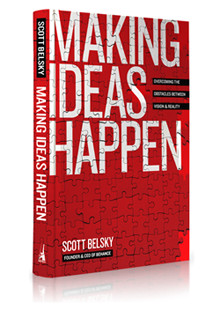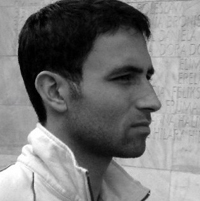
Scott’s approach to ‘productive creativity’ is closely aligned to the Lateral Action mantra of ‘creativity + productivity’, so I believe this is a book Lateral Action readers will want to have on their shelves.
I first came across Scott’s work three years ago, when I wrote an enthusiastic blog post about the productivity tools for creatives produced by his company Behance, and the Action Method philosophy that underpinned them. That post resulted in a friendly e-mail from Scott, which was the beginning of an ongoing dialogue about creativity, productivity and entrepreneurship.
Since then I’ve followed the development of Behance with great interest – we featured the Behance Network in our Top 10 Social Networks for Creative People, I’m a guest writer for their terrific magazine site The 99 Percent, and I’m frankly a little envious that I’m not going to make it to The 99 Percent Conference this year. The Action Method is now a fully-fledged productivity and collaboration software system for creative teams.
All of that, and Scott has somehow found the time to write a book, which launches today – more details here. As soon as I learned about the book I asked Scott if I could interview him about it for Lateral Action – here are his answers to my questions.
1. The creativity industry abounds with techniques for generating ideas – what made you decide to focus on execution instead of idea generation?

There is SO MUCH discussion in the creative world about inspiration and creativity, but very little discussion about organization and execution. I found this VERY frustrating. Too many ideas (and creative careers) suffer as a result of disorganization and careless engagement in creative projects. But some people and teams are able to consistently defy the odds and make their ideas happen, time and time again. We founded Behance (and I subsequently wrote my book) with the premise that we could help all creative people perpetuate the best practices we observed among the uber-productive.
2. Do you think the workflow challenges of creative professionals are qualitatively different to workers in other professions? Or are the differences more a matter of degree?
Well, I do think that creative professionals thrive on a workflow and process that is organic – one that they have modified and made personal. Only a personally-derived process will keep us engaged long enough to push bold ideas to fruition. We need to make process “sticky.” The problem with creative minds in large corporations is that bureaucratic tools don’t take personalization into account. As a result, we are stuck using bulky tools that repel us. No wonder creatives have a bad reputation when it comes to adhering with process!
Given the unique characteristics of the optimal workflow for creative people and teams, we face a unique set of challenges. I’m very interested in understanding these differences and how to reconcile them.
3. What do you mean by “reactionary workflow”? How can we overcome it?
In the era of Google Analytics and Twitter, we spend too much time obsessing over real-time data, just because it’s at our finger tips. Whether it is checking your site’s traffic or your bank account, these small repetitive actions don’t help you make ideas happen. They just help us feel safe. “Insecurity Work” is stuff that we do that (1) has no intended outcome, (2) does not move the ball forward in any way, and (3) is quick enough that you can do it multiple times a day without realizing – but, nonetheless, puts us at ease. The first step for reducing Insecurity Work is self-awareness. Recognize what you do in your everyday life that is, in fact, insecurity work. The second step is to establish some guidelines and rituals for yourself that provide more discipline. Perhaps you’ll try restricting all Insecurity Work to a specified 30 minute every day? The third step, if applicable to you, is to delegate the task of checking on this data to a less insecure colleague who can review the data periodically and report any concerns.
4. Here at Lateral Action we share your scepticism about the myth of the lonely creative genius. How does your book approach the issue of collaboration and creativity?
I talk a lot about the role of partnerships and the nuances of creative collaborations. While I don’t talk so much about “creativity” in partnerships, I do cover the other forces that, in my opinion, are absolutely critical to great executions. I talk about systems that foster accountability and the concept of “writers circles” that have spawned all sorts of groups across industries.
I also talk about the different categories of people I met during the research – the “doers,” “dreamers,” and what I have come to call the “incrementalists.” It turns out that we all have a set of strengths (and weaknesses) that should be taken into account when entering partnerships.
5. What is the “project plateau”? How can we get past it?
The project plateau is like an expansive desert, void of any oasis of inspiration or excitement. It is the pure drudgery in the middle stages of a project; ceaseless follow-ups and a lot of hard work with no clear end in sight. As we trudge our way through, we get easily distracted by life’s demands. As creative minds, we also come up with new ideas which entice us to escape the doldrums of the project plateau and start all over again with something new and shiny. The project plateau is especially difficult to endure without the usual short-term rewards that keep us motivated. The usual financial reward and fanfare won’t be there for you mid project.
You know you’re in a project’s plateau when you feel isolated and uncertain if your idea will ever see the light of day.
6. You’re clearly a busy man, with the Behance Network, Action Method,the 99% Conference and website, as well as your speaking and consulting work. How did you carve out time to write a book in the midst of all that? I assume you had to take plenty of your own advice!
Well, I have a phenomenal team that I work with. Matias, Behance’s Chief Designer, has been an incredible partner from the very early days of Behance. Without him, none of this would be possible. I was also fortunate to assemble a team of leaders – in technology – in methodology – and in operations – that all shared my passion to organize the creative world. Together, we have overcome some daunting challenges. I am grateful every day to come into work and collaborate with such a committed and inspiring team.
I also certainly paid a price for doing the book alongside the demands of running the business. Quite frankly, I worked extremely long hours and a constantly refined my system for managing projects. *sigh* There was lots of raw perspiration involved, no doubt.
7. Finally, what do you want this book to make happen?
I hope the book prompts more discussion about organization and execution in the creative world. I think there is too much emphasis on inspiration and the sources of creativity – the romantic pursuit of ideas – rather than what comes AFTER the idea. This book is all about the execution, and I hope it serves as a powerful catalyst for more introspection and discussion. I also hope that readers leave with at least 3-5 things that they will do differently in their creative projects. The book is full of practical tips that I’ve observed across industries. And while nobody will adopt ALL of them, I do think that a few critical tweaks can make all the difference.
Scott Belsky is CEO and Founder of Behance. His book Making Ideas Happen launches today. You can follow Scott on Twitter @scottbelsky.

Interesting.
If I am understanding this right, the “Insecurity Work” is actually “Security Work” kind of like the old phrase of “job security.”
There is so much that needs to be done, we need all the creative ideas and action we can have.
Thank you for defining Project Plateau! It’s like being ill & not knowing what you have – Knowing doesn’t cure it, but it can help put you in a direction that will have you feeling well once again. Now that my current state has been diagnosed, it’s time to plod through the mundane and get my web business going! Looking forward to reading the book —
Excellent interview, I look forward to the book!
Well-said Scott! (clicked the Amazon buy button before I finished the blog.
Duckie and I fight the work-flow thing every day! Even though we mostly Apple Macs, it’s easy to become stuck inside a graphic arts process … designed for giant work teams (but what about us single performer and couple work teams??
Nothing is straight-forward when you must begin with idea and then flow through design, production and on to successful marketing. We piece together little tools that work and keep chugging on!!! Almost like wading through little mine fields on the way to completion. (Ref: the Rush to Completion mentioned by Seth Godin.)
When I worked in the corporate world, I literally hid out at night and after midnight to complete the projects (employee training programs). Daytime became loaded with information overload and interruptions … and project redirections.
Thanks for the interview, Mark. Good luck to Scott’s book and I’m eagerly awaiting it.
Great interview guys!
Particularly enjoyed his explanation to your third question related to “reactionary workflow”.
Scott is amazingly inspiring and excited to hear him speak at Big Omaha (http://www.BigOmaha.com) next month!